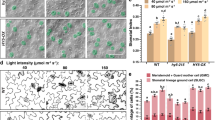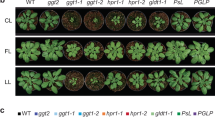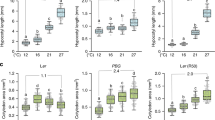Abstract
PHOTOCONTROL of elongation growth has been extensively studied in dark-grown (etiolated) seedlings for some time. However, only relatively recently has detailed attention been given to green (de-etiolated) plants. One reason for this is that the photoreceptor, phytochrome, can easily be detected spectrophotometrically in non-green tissues but not in tissue containing chlorophyll. There is agreement that the photoreceptor operates in its low-energy mode (low irradiances or fluence rates, with red/far-red reversibility) in green seedlings as well as in dark-grown, non-green seedlings. In its high-energy mode (high irradiances and time dependency), exemplified by the action of prolonged irradiation with far-red, phytochrome might act only in etiolated seedlings1–3. Photoregulation of stem extension in etiolated and de-etiolated seedlings is also achieved by blue light (400–500 nm), but it is still not clear if a photoreceptor other than phytochrome is responsible for this effect. Kinetic studies on etiolated seedlings suggest the operation of a separate blue-responsive photosystem2. Notwithstanding this, it has recently been suggested that in green seedlings blue-light control of hypocotyl extension is due solely to absorption by phytochrome4. This claim, together with the evidence that changes in phytochrome photoequilibria can exert profound effects upon stem extension, may lead one to believe that this is the major photoreceptor controlling elongation growth in green plants. We report here, however, work that strongly indicates that two separate pigment systems control hypocotyl extension in green seedlings—phytochrome and a separate blue-lightreceptor. Both systems produce the same response—inhibition—but we have found it possible to separate their effects by examining the times at which the response commences.
This is a preview of subscription content, access via your institution
Access options
Subscribe to this journal
Receive 51 print issues and online access
$199.00 per year
only $3.90 per issue
Buy this article
- Purchase on Springer Link
- Instant access to full article PDF
Prices may be subject to local taxes which are calculated during checkout
Similar content being viewed by others
References
Black, M. & Shuttleworth, J. E. Planta 117, 57–66 (1974).
Meijer, G. Acta Bot. Neerl. 17, 9–14 (1968).
Jose, A. M. & Vince-Prue, D. Planta 136, 131–134 (1977).
Wilderman, A., Drumm, H., Schäfer, E. & Mohr, H. Planta 141, 211–216 (1978).
Holmes, M. G. & Smith, H. Photochem. Photobiol. 25, 551–557 (1977). Morgan, D. C. & Smith, H. Planta 142, 187–193 (1978). Morgan, D. C. & Smith, H. Nature 262, 210–212 (1976).
Shuttleworth, J. E. & Black, M. Planta 135, 51–55 (1977).
Jose, A. Planta 136, 125–129 (1977).
Briggs, W. R. in Light and Plant Development (ed. H. Smith) (Butterworth, London, 1976).
Presti, D. & Delbrück, M. Plant, Cell Environ. 1, 81–100 (1978).
McLaren, J. S. & Smith, H. Plant, Cell Environ. 1, 61–67 (1978).
Morgan, D. C. & Smith, H. Nature 273, 535–537 (1978).
Author information
Authors and Affiliations
Rights and permissions
About this article
Cite this article
GABA, V., BLACK, M. Two separate photoreceptors control hypocotyl growth in green seedlings. Nature 278, 51–54 (1979). https://doi.org/10.1038/278051a0
Received:
Accepted:
Published:
Issue Date:
DOI: https://doi.org/10.1038/278051a0
This article is cited by
-
Photoregulation of growth and branching of plum shoots: Physiological action of two photosystems
In Vitro Cellular & Developmental Biology - Plant (2001)
-
Influence of UV-light on carthamin accumulation and floret elongation in a cultivar of saffron thistle (Carthamus tinctorius L.)
Acta Physiologiae Plantarum (2000)
-
Large plasma-membrane depolarization precedes rapid blue-light-induced growth inhibition in cucumber
Planta (1989)
-
Redistribution of growth during phototropism and nutation in the pea epicotyl
Planta (1986)
-
Fluence-response curves and action spectra for promotion and inhibition of seed germination in wildtype and long-hypocotyl mutants of Arabidopsis thaliana L.
Planta (1985)
Comments
By submitting a comment you agree to abide by our Terms and Community Guidelines. If you find something abusive or that does not comply with our terms or guidelines please flag it as inappropriate.



